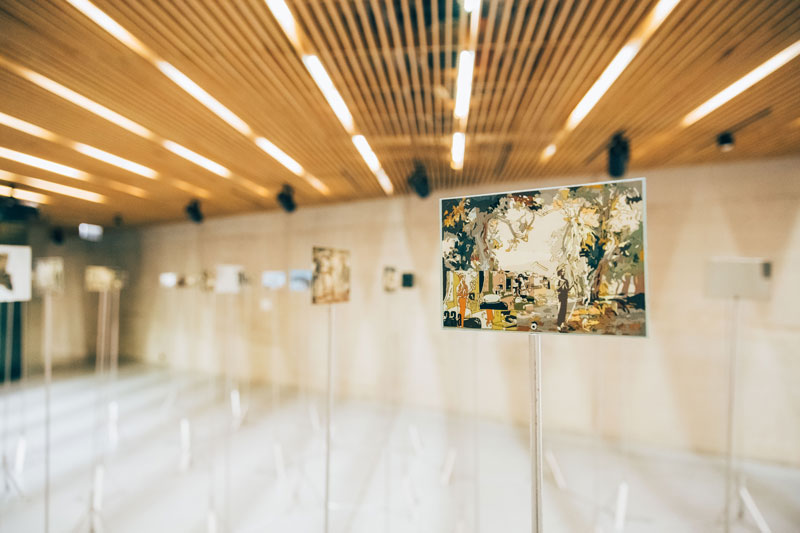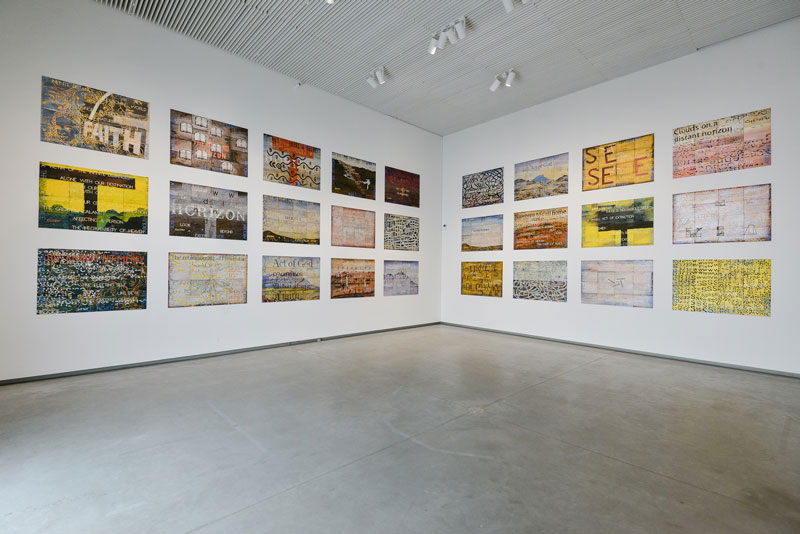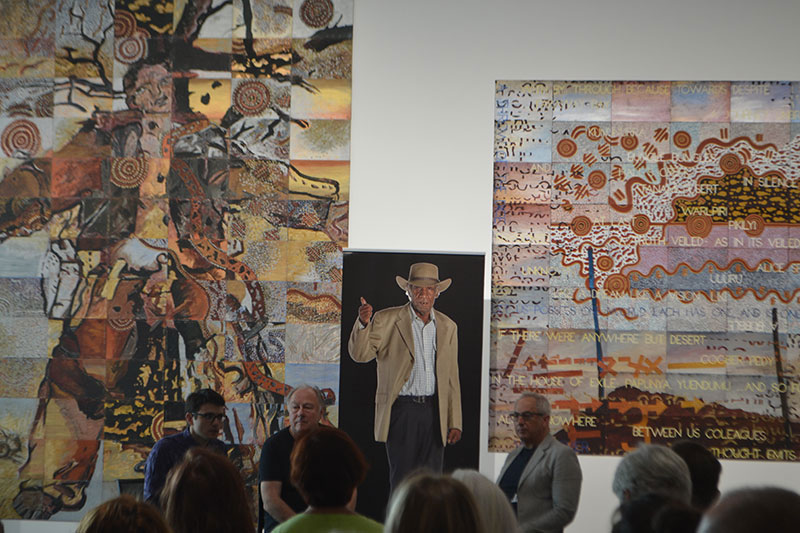
A large contingent of Australians made the long journey to Riga for the opening of Imants Tillers’ exhibition at the Latvian National Museum of Art to find its enthusiasm eclipsed by Tillers’ Latvian profile. As well as the lavish opening there was a catalogue that is the most extensive and handsomely produced publication on his work (including a revealing essay by Tillers) and an enthralling 90‑minute documentary film made especially for the event: Thrown into the World directed by Antra Cilinska. The night before the opening, a gala premier screening at Riga’s renowned Rococo styled theatre made sure that a Latvian perspective framed our experience of Tillers’ art.
One reason Tillers receives such attention in Latvia (even the hotel doorman was excited) is because, unlike in Crocodile Dundee land, the arts play a central role in the Latvian sense of national being—although in Latvia the performing not visual arts are king. Here they are truly mass communal participatory practices, and as such are potent mediums of social solidarity. The focus of national celebration is the Latvian Song and Dance Festival, a week-long summer celebration held every five years, which was inaugurated in 1873 as a manifestation of an emerging nationalism. Singing is so much part of the national psyche that the restoration of independence on 4 May 1990 was accompanied by large singing crowds—the so‑called “singing revolution”—which swelled into the squares to forestall Russian tanks.
The opening of Tillers’ exhibition during this year’s Song and Dance Festival, which coincided with the centenary celebrations of Latvian independence in 1918, is an indication of his standing in Latvia’s national consciousness as well as a growing Latvian interest in the visual arts. With Vija Celmins—Latvia’s even more famous expatriate visual artist—Tillers was a special guest at the Festival finale. Both were seated in the front row with former Latvian presidents.
Latvian nationalism might seem an odd focus for a review of the Tillers exhibition, given that diaspora, transnationalism and post-identity are central themes of his art, but these are also the galvanising themes of Latvian history and so Latvian Being, and painting is at least equal to telling this story as song. It is estimated that 20 per cent (300,000) of Latvians live abroad, and the 1,200,000 that remain in Latvia comprise only 60 per cent of the country’s population. Around 30 per cent of people living in Latvia are of Russian ethnic origin. Thus, like the Ukraine, Latvia is vulnerable to Putin’s politicking especially now as Trump’s foreign policy is creating enormous apprehension in the region. A nation does not need its own state to feel its unity but a level of anxiety about its coherence and sovereignty as a people helps.

Latvia has many more reasons than Trump and Putin to be anxious, all of them to do with its history. It might be celebrating its centenary of independence but for 50 of these years Latvia was under the rule of either Hitler’s Germany or (mainly) Russia. If Indigenous Australians have had it tough, Latvians have been colonised for over 800 years—since Teutonic Knights began a 200‑year campaign to defeat the indigenous Baltic tribes and convert them to Christianity. Eventually these tribes were subjected to a new feudal economy under the auspices of a Prussian aristocracy. Over the centuries it served Polish, Swedish and Russian empires, though with a degree of autonomy that aided the development of a Latvian consciousness.
By the eighteenth century, Latvia had evolved into a provincial but prosperous modern European society within the Swedish empire. Kant’s first critique was first published in Riga in 1781, then Sweden’s largest city. Within a decade, as the British colony of New South Wales struggled to survive its first years, Sweden lost its Baltic provinces to the Russian empire. The twentieth century was no better: Latvia was racked with war, mass deportations and ethnic cleansings.
Perhaps the joy of singing and dancing, so prominent in the Latvian psyche, helps put behind past trauma. Or maybe this summer festival of song and dance is really about forgetting the long winter. Like summer, independence is seasonal and should by enjoyed before the long night returns. Whoever thinks they rule Latvia, Latvians know that nature rules and so it is to her that they turn their ears. This is surely why the curator, Latvian art historian Elita Ansone, devoted the last room in the exhibition to 45 works from Tillers’ Nature Speaks series (1998–2006), hung salon style as one installation.

Even though Journey to Nowhere includes early through to recent work, Ansone has not curated a retrospective. Rather, she tracks the Latvian currents that run through Tillers’ work. She has us enter this Latvian narrative via a cut‑down version of Tillers’ early installation, Conversations with the Bride (1974–75), which established his reputation as an artist and also the future direction of his canvas board project that has preoccupied him for nearly 40 years. A conversation between the French–American Marcel Duchamp and German–Australian Hans Heysen, it speaks to the themes of transnationalism and provincialism that would drive Tillers’ future work.
More importantly, it clearly established his conceptualist interest in systems, in which orderly relations of difference underpin artmaking, lending it a sense of scientific objectivity. More to the point for Tillers is that his art rises before us like a language, as a thought (for it is by language that we think) rather than a representation. This is why the cut‑down version of Conversations with the Bride was sufficient: the fragment retains the integrity of the system. Here it sets in play never-resolved and so never-ending dialectical exchanges between images, and images and audience. This would become the starting point of Tillers’ Book of Power, which is what he eventually called his canvas board project.
.jpg)
Conversations with the Bride leads into the Great Exhibition Hall, in which hangs about a dozen very large paintings—some over eight meters in length—and several smaller works. I thought of this as the Old Testament room: like one of its books each large work was a complete set of weighty allegorical narratives that trace the tragic search of a people for their destiny. Ansone has chosen works that speak directly to Latvian and Indigenous Australian themes, which since he began the Book of Power Tillers has used as parallel perspectives on his personal journey to nowhere.
At the far end of the Great Exhibition Hall is The Nine Shots (1985), a towering painting that firmly established Tillers’ association with Indigenous art and would shape his career more than any other—especially his later collaborations with the Warlpiri artist Michael Nelson Jagamara. Next to it hangs their remake of The Nine Shots, Fatherland (2008). As if to make a point, during a public conversation with Tillers, Michael Eather (who is the mediator between Tillers and Jagamara) installed between these two paintings a larger than life‑size photograph of Jagamara.
The Nine Shots is dominated by a large central figure appropriated from one of Baselitz’s “der neuer Typ” (the new man) paintings of the 1960s, which depict the fractured, disorientated and angst-ridden image of a traumatised soldier as an emblem of postwar identity. Here he is splayed Christ‑like on a tree, with a snake rising up the length of his body. During a talk, Tillers revealed that this new man was intended as an image of the Australian frontier colonist—such as, Tillers continued with a grin, the Latvian refugee Arvids Blumentāls from Dundaga, who in the 1950s became a legendary crocodile hunter and the basis for that quintessential Aussie, Crocodile Dundee.

The first painting encountered in the Great Exhibition Hall, hanging next to a portrait of Kant, is a recent self‑portrait, in which a stony face stares out like some old Jewish prophet through a wall of cascading text that has been a feature of Tillers’ art since the early 1990s, in other words, since the “singing revolution.” The text comprises pithy fragments drawn from poets (Novalis and Mallarme are favourites), philosophers (Heidegger is the favourite) and place and language names (many of which are Indigenous), and which generally evoke metaphysical and existential questions about the nature of being.
Like verses to be sung, the text of Tillers’ paintings adds a sonic dimension to his work that, in Latvia, could not be missed. This was clear at the exhibition’s opening, when two musical compositions written by the Australian composer Rosalind Page were performed. They included a deeply melancholy piano, cello and clarinet composition called “Being and Time,” which evoked the endless longing of loss that pervades much of Tillers’ art, and a choral piece written for the occasion based on the text in the paintings on the wall, all the more powerful for being performed with the paintings. In this singing of the paintings one felt the age‑old Indigenous encounter between painting and song, and also an evocative joining of Tillers’ exhibition with the Music and Dance Festival literally occurring outside in the park in which the museum is situated.
If these large paintings in the Great Exhibition Hall spoke to Latvia’s traumatic history, one left the exhibition via the smaller sunny sky‑lit gallery that contained the Nature Speaks series, which for me was the more redemptive New Testament room that spoke to Latvia’s hopes. Tillers began the Nature Speaks series in the 1990s. In Australia they are often associated with his move from Sydney to Cooma, but here I realise they have another context as the 1990s is when Latvia won its most recent independence. Listening to Rupert Myer’s opening speech, in which he gently arranged his thoughts from carefully‑crafted phrases he had plucked like flowers from Tillers’ paintings, I could not help noticing Tillers sitting in the front row, poignant like the prodigal son’s homecoming.
Now in his 68th year and surrounded by family, Tillers seemed to sit there with a lightness of being while heavy in thought. Born of refugees who dreamed of returning from their antipodean exile but now lying in Australian soil, as the eldest son he has finally redeemed their longing of return as if this was his life’s journey, and as if he had finally fulfilled a destiny they had bequeathed him. Journey to Nowhere seemed a memorial to them and by implication all refugees. If Tillers thus sought peace for their souls, as he admitted on the opening night, he can now return to the road. His job done, the prodigal son enjoyed this homecoming party, indeed he was visibly moved, but he was now too unsettled in an Australian sort of way—or is it a contemporary sort of way—to stay.
The work in this exhibition said it all: it was on a journey to nowhere. There would be no arrival; it had not found “the unity of identity [that] speaks of the Being of beings,”[1] to use Heidegger’s phrase. Rather, Tillers remains entranced by “the difference between Being and beings,”[2] caught in what Heidegger called “the event of appropriation”[3] through which Being and humanity “are delivered over to each other” in the dialectical movements of the thought of language. Tillers finds solace not in the sameness of identity, in which “one is always enough,”[4] but in the “mutual appropriation” between difference that requires two. This is why he constructs a system of differences across his canvases in which images and texts are arranged like language. Reading the text slows the darting eyes of the viewers’ restless minds so they will pause for a conversation with the ideas that float like songs through the canvases. This exhibition reveals a very Latvian Tillers, but this in itself is a lesson for those Australians who have followed his meditations on their histories. Journey to Nowhere holds a post‑national mirror to its Latvian and Australian audience.
Footnotes













